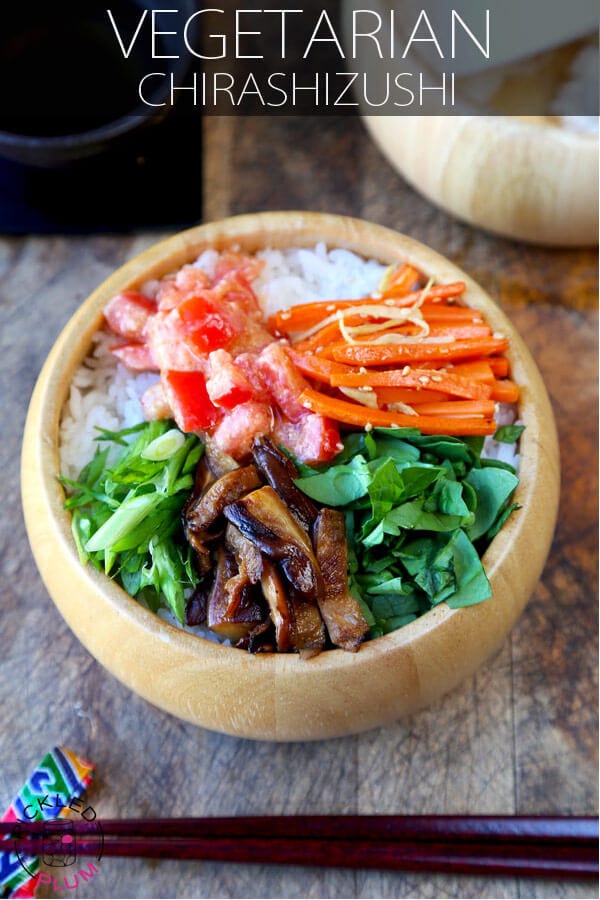

To do this, you want to rinse the excess starch off of the surface of the rice by putting it in a sieve and agitating it with your hands under cold running water. The first thing you want to do is prepare the rice.

I’ve also used some edible shiso flowers as an added touch at the end, but you can garnish with any edible flowers or fresh herbs you have on hand. I cut the snap peas into leaves for some extra visual impact, and I used a vegetable cutter to cut my carrots into flowers. I’ve used crisp snap peas and sweet carrots, along with some nutty sesame.
Garnishes – Pick garnishes that really make the color and texture pop. I’m topping this with thin threads of egg called Kinshi Tamago, but you can also make Tamagoyaki (Japanese rolled omelet) and cut it up into slices or cubes. Egg – Egg is a popular topping for Chirashi Sushi because it’s colorful and adds protein, especially if you plan on making it without seafood. I’ve included a mix of raw tuna and poached shrimp for my version and, to make it a little extra, I’ve also used some ikura. My mom would occasionally top her version with boiled shrimp, but usually, it was topped with shiitake mushrooms, carrots, egg, snow peas, and red pickled ginger. Seafood – Seafood is not the focus of most versions of Chirashi Sushi, which makes it totally optional. The mixture can also make quick pickles, marinades, and potato salad, so I always like to make a big batch and keep it in a squeeze bottle. Vegetarian chirashi how to#
For this recipe, I will show you how to make it from scratch, but you can also use a pre-mixed one like Mizkan’s Seasoned Rice Vinegar.
Sushi Vinegar – Sushi vinegar is a sweet, sour, and slightly salty seasoning made by mixing rice vinegar with sugar and salt. I do not recommend trying to make this with long-grain rice. Medium grain varietals such as Calrose will work, but it’s not ideal. Amylopectin also takes much longer to retrograde than amylose, which means short-grain rice won’t get hard when it’s served at room temperature. This is because short-grain rice has a higher ratio of amylopectin to amylose, which gives it a sticky texture that’s a hallmark of good sushi rice. Rice – Sushi is best made using Japanese short-grain rice. This makes it a super flexible dish that can be made almost anywhere. As long as you remember to keep a good balance of these, you can top this with any combination of ingredients you like. Part of the appeal of Chirashi Sushi is the rainbow of colors, textures, and flavors scattered over the sushi rice. When it comes to mixing the rice with the sushi vinegar, the key is to get the seasoning to coat every grain of rice without breaking the rice grains and then cooling it rapidly, so the rice doesn’t turn mushy. This starts by rinsing the excess starch off the rice’s surface, soaking it in water to rehydrate the grains, and then cooking and steaming the rice. 
It’s also important to cook the rice well.Aside from using good, Japanese short-grain rice, an authentic Japanese rice vinegar like Mizkan’s Natural Rice Vinegar is the key to making great sushi rice. This is why it’s so important to get the sushi rice right. Many people assume that raw fish is at the heart of all sushi, but it’s the vinegared sushi rice that most modern styles of sushi have in common.Now that I’m back in Japan, I have many choices, but they’re still my go-to brand for rice vinegar. It’s the brand of vinegar my mom always used for making her Chirashi Sushi when I was growing up in the US. Mizkan is a family-owned Japanese brand that’s been making vinegar and sauces for over 215 years. That’s why this Chirashi bowl was one of the first recipes to come to mind when Mizkan™ offered to sponsor a recipe here. With sushi rice topped with a scattering of colorful toppings, it’s an easy, flexible way of making sushi at home using the ingredients that are available to you. Chirashi Sushi is a traditional style of Japanese sushi that’s probably the inspiration behind most modern sushi bowls.







 0 kommentar(er)
0 kommentar(er)
